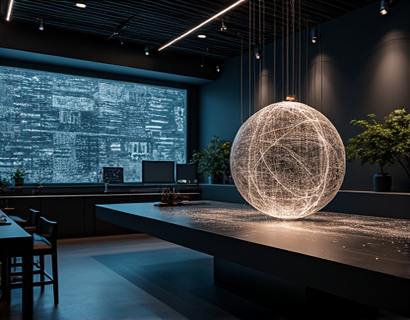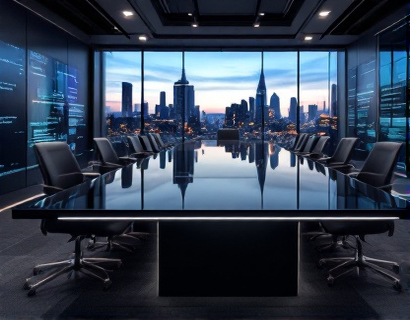Transforming Daily Life with Augmented Reality E-Commerce
In the rapidly evolving landscape of e-commerce, augmented reality (AR) has emerged as a transformative force, redefining how consumers interact with products and services. This technology, once confined to the realms of gaming and entertainment, is now being harnessed to enhance the shopping experience, offering a blend of the physical and digital worlds. For tech-savvy consumers eager to embrace the latest innovations, AR e-commerce presents a unique opportunity to elevate their lifestyle through cutting-edge products that seamlessly integrate into daily routines.
The core idea behind AR e-commerce is to provide users with an immersive and interactive shopping experience. Unlike traditional online shopping, where customers view static images or videos of products, AR allows them to visualize items in their own environment before making a purchase. This not only enhances the shopping experience but also reduces the likelihood of returns, as consumers can better assess how a product will fit into their space or complement their existing possessions.
Understanding Augmented Reality in E-Commerce
Augmented reality in e-commerce leverages the capabilities of smartphones and tablets to overlay digital information onto the real world. This is achieved through the device's camera, which captures the user's surroundings and superimposes virtual objects or information. For instance, a consumer looking to buy furniture can use an AR app to see how a sofa would look in their living room, adjusting the size, color, and position to find the perfect fit.
The technology behind AR e-commerce involves several key components. Computer vision algorithms analyze the camera feed to understand the environment, while 3D modeling and rendering techniques create realistic representations of products. Machine learning algorithms further enhance the experience by personalizing recommendations based on user preferences and past interactions. This synergy of technologies ensures a smooth and engaging user experience, making AR a powerful tool for e-commerce platforms.
Benefits of AR for Consumers
For consumers, the benefits of AR e-commerce are manifold. Firstly, it provides a more accurate representation of products, reducing the uncertainty and risk associated with online shopping. This is particularly valuable for high-ticket items such as furniture, home decor, and fashion, where fit and appearance are crucial. By visualizing products in their own space, consumers can make more informed decisions, leading to higher satisfaction and fewer returns.
Additionally, AR enhances the shopping experience by making it more interactive and fun. Instead of scrolling through pages of images, users can engage with products in a dynamic and immersive way. This not only keeps users engaged but also increases the likelihood of a purchase. For instance, a fashion brand could allow users to virtually try on clothes and accessories, providing a personalized and enjoyable experience that traditional e-commerce cannot match.
AR for Lifestyle Enhancement
Beyond mere product visualization, AR e-commerce offers a broader scope for lifestyle enhancement. By integrating AR into various aspects of daily life, consumers can discover and adopt innovative solutions that make their lives easier, more convenient, and more enjoyable. For example, AR can be used to enhance home organization and decor. An AR app could suggest optimal placement for storage solutions, lighting, and artwork, transforming a mundane task into an exciting design process.
In the realm of fitness and wellness, AR can provide interactive workout guides and nutritional information, helping users achieve their health goals in a more engaging manner. Imagine following a yoga routine where virtual instructors guide you through poses, or scanning a food item to instantly access its nutritional content and recipe suggestions. These applications of AR not only enhance the user experience but also contribute to a healthier and more balanced lifestyle.
Technological Advancements in AR E-Commerce
The evolution of AR e-commerce is closely tied to advancements in technology. Improvements in mobile hardware, such as higher-resolution cameras and more powerful processors, have made AR experiences smoother and more realistic. Additionally, the development of AR-specific platforms and frameworks, such as ARKit for iOS and ARCore for Android, has simplified the process of creating AR applications, making it more accessible for e-commerce businesses.
Another significant advancement is the integration of AR with other technologies like artificial intelligence (AI) and the Internet of Things (IoT). AI can enhance AR experiences by providing personalized recommendations and predictive analytics, while IoT devices can interact with AR applications to create a more connected and intelligent environment. For instance, an AR app could work with smart home devices to suggest furniture that complements existing IoT setups, creating a cohesive and functional living space.
Case Studies: Successful AR E-Commerce Implementations
Several e-commerce platforms have successfully integrated AR into their offerings, demonstrating the potential of this technology. IKEA Place, for example, allows users to visualize furniture in their homes before purchasing. By using their smartphone camera, users can see how a sofa or table would look and fit in their space, making the decision-making process more straightforward and confident.
Another notable example is Sephora's Virtual Artist, an AR app that lets users try on makeup virtually. Users can select products, apply them to their face, and see how they look in real-time. This not only enhances the shopping experience but also helps customers find the perfect makeup match without the need for physical samples, aligning with the brand's commitment to sustainability.
These case studies highlight the versatility and effectiveness of AR in e-commerce, showcasing how it can be tailored to different industries and consumer needs. By providing practical and engaging solutions, these platforms set a benchmark for others to follow.
Challenges and Considerations
While the potential of AR e-commerce is vast, there are several challenges and considerations that businesses must address. One of the primary challenges is ensuring a seamless and user-friendly experience. AR applications require precise alignment and rendering, which can be affected by factors such as lighting conditions and device capabilities. Developers must optimize their apps to work across a range of devices and environments, ensuring consistency and reliability.
Another consideration is privacy and data security. AR applications often require access to the user's camera and location data, raising concerns about how this information is used and protected. E-commerce platforms must implement robust security measures and be transparent about data usage to build trust with consumers.
Additionally, there is a learning curve associated with AR technology. Not all consumers are familiar with AR, and some may be hesitant to adopt new technologies. Educating users about the benefits and ease of use of AR applications is crucial for widespread adoption. Providing tutorials, guided tours, and clear instructions can help overcome this barrier and encourage more users to try AR-enhanced shopping experiences.
Future Trends in AR E-Commerce
Looking ahead, the future of AR e-commerce is promising, with several trends poised to shape the industry. One such trend is the integration of AR with virtual reality (VR) to create hybrid shopping experiences. While AR enhances the real world, VR can transport users to entirely virtual environments, offering a more immersive and interactive shopping experience. Imagine browsing a virtual store, interacting with products, and even attending virtual fashion shows—all from the comfort of your home.
Another trend is the use of AR for social commerce. Platforms like Instagram and Snapchat have already started incorporating AR filters and effects that allow users to share their shopping experiences with friends and followers. This social aspect not only enhances engagement but also drives traffic to e-commerce sites. Brands can leverage these features to create viral marketing campaigns and build community around their products.
Furthermore, the rise of 5G technology will play a significant role in the growth of AR e-commerce. With faster and more reliable internet connections, AR applications will become more responsive and high-quality, reducing latency and improving the overall user experience. This will enable more complex and sophisticated AR experiences, opening up new possibilities for e-commerce platforms.
Conclusion
Augmented reality e-commerce represents a significant leap forward in the way we shop and interact with products. By blending the physical and digital worlds, AR offers a more accurate, engaging, and personalized shopping experience. For tech-savvy consumers eager to embrace innovation, AR e-commerce provides a platform to discover and integrate cutting-edge products into their daily lives. As technology continues to advance and more businesses adopt AR solutions, the future of e-commerce looks brighter and more interactive than ever before.










































